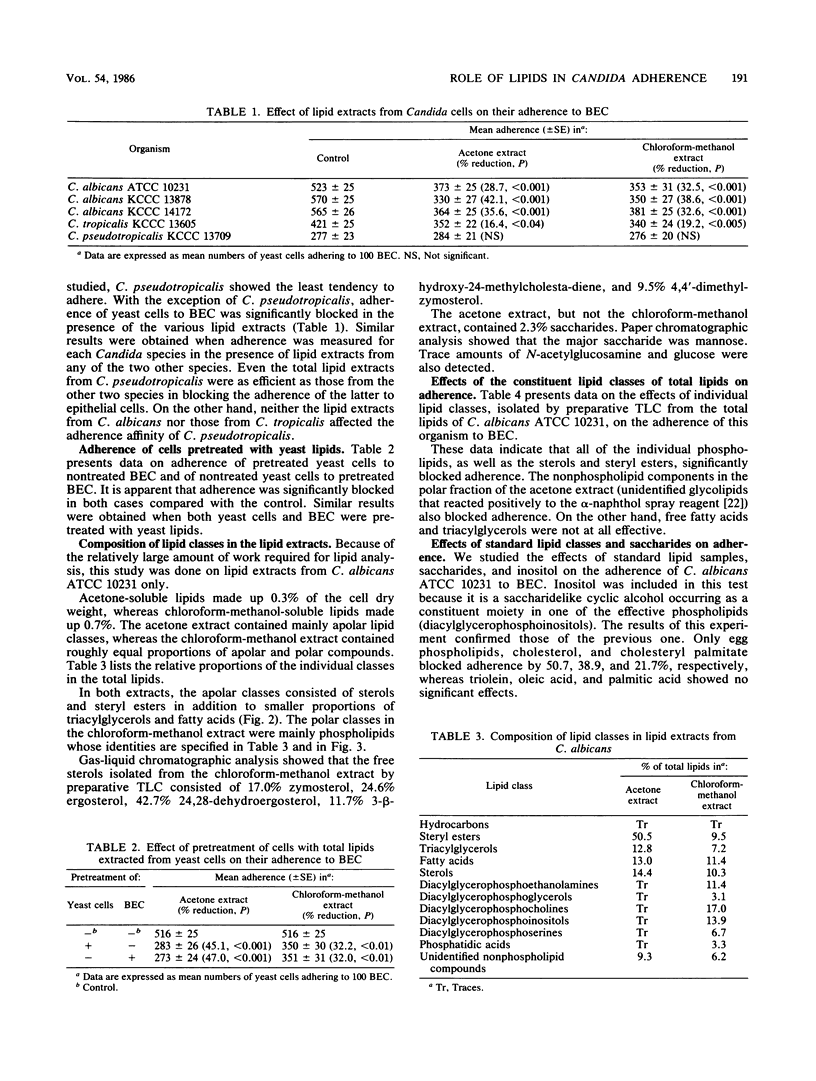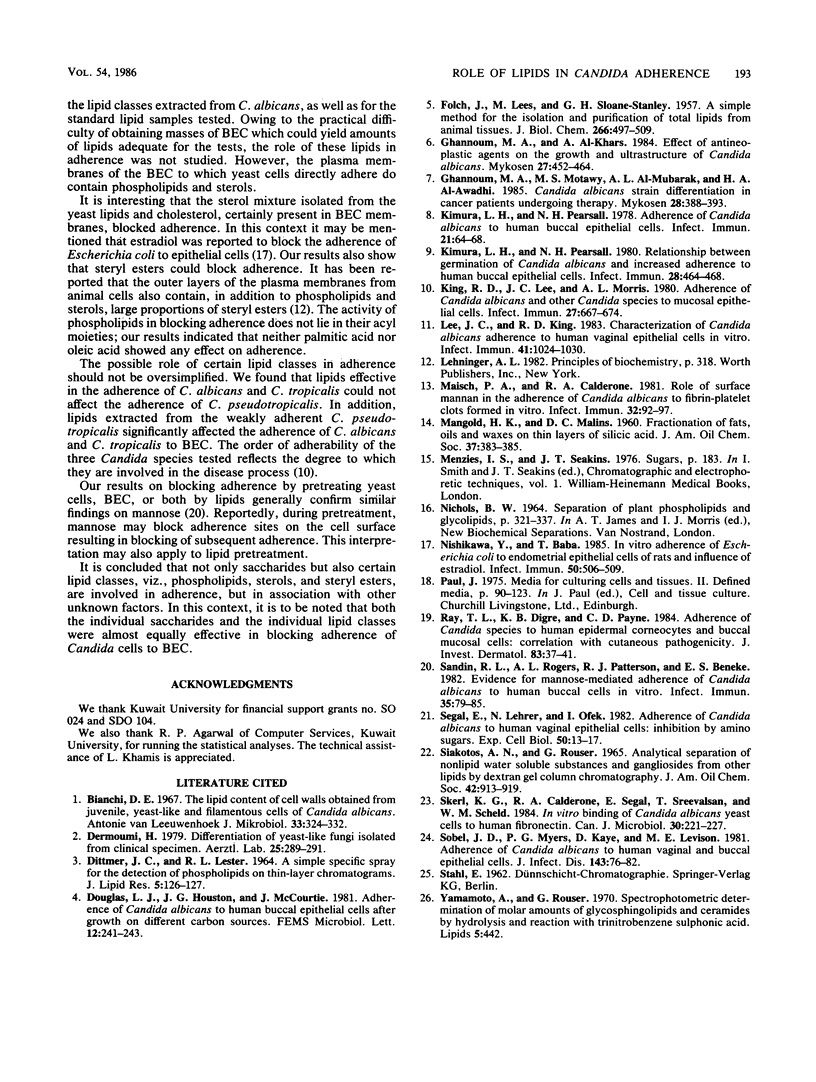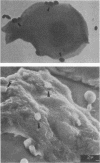Abstract
Lipids extracted from Candida albicans and C. tropicalis, but not from the weakly adherent C. pseudotropicalis, significantly blocked in vitro adherence of the respective yeast cells to buccal epithelial cells. The percentage of reduction from control values ranged between 16.4 and 42.1%, depending on the species, the strain, and the solvent used for lipid extraction. The constituent lipid classes of both the acetone and chloroform-methanol extracts of C. albicans ATCC 10231 were qualitatively and quantitatively analyzed. The individual classes were isolated by preparative thin-layer chromatography and then tested for their effects on the adherence of this strain to buccal epithelial cells. Individual phospholipids, sterols, and steryl esters blocked adherence significantly (between 15.5 and 55.7% reduction). Triacylglycerols and free fatty acids showed no effect whatsoever. The same results were obtained when standard lipid samples were investigated.
Full text
PDF




Images in this article
Selected References
These references are in PubMed. This may not be the complete list of references from this article.
- Bianchi D. E. The lipid content of cell walls obtained from juvenile, yeast-like and filamentous cells of Candida albicans. Antonie Van Leeuwenhoek. 1967;33(3):324–332. doi: 10.1007/BF02045577. [DOI] [PubMed] [Google Scholar]
- DITTMER J. C., LESTER R. L. A SIMPLE, SPECIFIC SPRAY FOR THE DETECTION OF PHOSPHOLIPIDS ON THIN-LAYER CHROMATOGRAMS. J Lipid Res. 1964 Jan;5:126–127. [PubMed] [Google Scholar]
- FOLCH J., LEES M., SLOANE STANLEY G. H. A simple method for the isolation and purification of total lipides from animal tissues. J Biol Chem. 1957 May;226(1):497–509. [PubMed] [Google Scholar]
- Ghannoum M. A., Al-Khars A. Effect of antineoplastic agents on the growth and ultrastructure of Candida albicans. Mykosen. 1984 Sep;27(9):452–464. doi: 10.1111/j.1439-0507.1984.tb02060.x. [DOI] [PubMed] [Google Scholar]
- Ghannoum M. A., Motawy M. S., Al-Mubarek A. L., Al-Awadhi H. A. Candida albicans strain differentiation in cancer patients undergoing therapy. Mykosen. 1985 Aug;28(8):388–393. doi: 10.1111/j.1439-0507.1985.tb02149.x. [DOI] [PubMed] [Google Scholar]
- Kimura L. H., Pearsall N. N. Adherence of Candida albicans to human buccal epithelial cells. Infect Immun. 1978 Jul;21(1):64–68. doi: 10.1128/iai.21.1.64-68.1978. [DOI] [PMC free article] [PubMed] [Google Scholar]
- Kimura L. H., Pearsall N. N. Relationship between germination of Candida albicans and increased adherence to human buccal epithelial cells. Infect Immun. 1980 May;28(2):464–468. doi: 10.1128/iai.28.2.464-468.1980. [DOI] [PMC free article] [PubMed] [Google Scholar]
- King R. D., Lee J. C., Morris A. L. Adherence of Candida albicans and other Candida species to mucosal epithelial cells. Infect Immun. 1980 Feb;27(2):667–674. doi: 10.1128/iai.27.2.667-674.1980. [DOI] [PMC free article] [PubMed] [Google Scholar]
- Lee J. C., King R. D. Characterization of Candida albicans adherence to human vaginal epithelial cells in vitro. Infect Immun. 1983 Sep;41(3):1024–1030. doi: 10.1128/iai.41.3.1024-1030.1983. [DOI] [PMC free article] [PubMed] [Google Scholar]
- Maisch P. A., Calderone R. A. Role of surface mannan in the adherence of Candida albicans to fibrin-platelet clots formed in vitro. Infect Immun. 1981 Apr;32(1):92–97. doi: 10.1128/iai.32.1.92-97.1981. [DOI] [PMC free article] [PubMed] [Google Scholar]
- Nishikawa Y., Baba T. In vitro adherence of Escherichia coli to endometrial epithelial cells of rats and influence of estradiol. Infect Immun. 1985 Nov;50(2):506–509. doi: 10.1128/iai.50.2.506-509.1985. [DOI] [PMC free article] [PubMed] [Google Scholar]
- Ray T. L., Digre K. B., Payne C. D. Adherence of Candida species to human epidermal corneocytes and buccal mucosal cells: correlation with cutaneous pathogenicity. J Invest Dermatol. 1984 Jul;83(1):37–41. doi: 10.1111/1523-1747.ep12261661. [DOI] [PubMed] [Google Scholar]
- Sandin R. L., Rogers A. L., Patterson R. J., Beneke E. S. Evidence for mannose-mediated adherence of Candida albicans to human buccal cells in vitro. Infect Immun. 1982 Jan;35(1):79–85. doi: 10.1128/iai.35.1.79-85.1982. [DOI] [PMC free article] [PubMed] [Google Scholar]
- Segal E., Lehrer N., Ofek I. Adherence of Candida albicans to human vaginal epithelial cells: inhibition by amino sugars. Exp Cell Biol. 1982;50(1):13–17. doi: 10.1159/000163121. [DOI] [PubMed] [Google Scholar]
- Siakotos A. N. Analytical separation of nonlipid water soluble substances and gangliosides from other lipids by dextran gel column chromatography. J Am Oil Chem Soc. 1965 Nov;42(11):913–919. doi: 10.1007/BF02632444. [DOI] [PubMed] [Google Scholar]
- Skerl K. G., Calderone R. A., Segal E., Sreevalsan T., Scheld W. M. In vitro binding of Candida albicans yeast cells to human fibronectin. Can J Microbiol. 1984 Feb;30(2):221–227. doi: 10.1139/m84-033. [DOI] [PubMed] [Google Scholar]
- Sobel J. D., Myers P. G., Kaye D., Levison M. E. Adherence of Candida albicans to human vaginal and buccal epithelial cells. J Infect Dis. 1981 Jan;143(1):76–82. doi: 10.1093/infdis/143.1.76. [DOI] [PubMed] [Google Scholar]
- Yamamoto A., Rouser G. Spectrophotometric determination of molar amounts of glycosphingolipids and ceramide by hydrolysis and reaction with trinitrobenzenesulfonic acid. Lipids. 1970 Apr;5(4):442–444. doi: 10.1007/BF02532112. [DOI] [PubMed] [Google Scholar]





